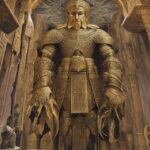In the vast realm of legendary fantasy literature, certain tales truly stand the test of time, captivating readers across generations and whisking them away into mystical worlds. Among these cherished narratives, “The Voyage of the Dawn Treader” rests as a bewitching masterpiece, renowned for its enchanting adventures and profound lessons. Authored by the illustrious C.S. Lewis, the ingenious mind behind the beloved Chronicles of Narnia series, this third installment beckons readers on an enthralling odyssey like no other. With its time-honored themes of discovery, redemption, and the triumph of the human spirit, this exhilarating voyage is a timeless beacon of inspiration.
Brace yourself for a treasure trove of marvels as we delve into the bewildering depths of “The Voyage of the Dawn Treader,” unveiling its captivating narrative, delving into its historical significance, and uncovering the profound wisdom it holds. Prepare to embark on an extraordinary journey, where every chapter promises to reignite the spark of imagination and leave you yearning for more.
The Voyage of the Dawn Treader: Full Book Summary
Once upon a time, there were four siblings named Lucy, Edmund, Susan, and Peter. They had experienced many magical adventures together in a land called Narnia. But now, they were back in the real world, longing for more excitement.
One day, while they were staying at their cousin Eustace’s house, something extraordinary occurred. As they stood by a painting of a ship in Lucy’s room, the painting started to come to life! Water began pouring out and the children felt the ship beneath their feet. They had been transported into the world of Narnia once again.
But this time, they were not alone. Eustace, a rather grumpy and selfish boy, had also been dragged into this incredible journey. Lucy, Edmund, and Peter were thrilled to be back, but Eustace quickly complained about everything. As the ship sailed on, they realized that they were aboard a magnificent vessel called the Dawn Treader, led by none other than their old friend, King Caspian.
King Caspian explained that he was on a mission to find seven lost lords who had disappeared during his absence. These lords were loyal to his father, but during his reign, they had been wrongly banished by his evil uncle, Miraz. Determined to right the wrongs, King Caspian set sail to find the missing lords, with the help of our four brave heroes.
Their journey was full of excitement, danger, and encounters with magical creatures. The first island they came across was inhabited by invisible creatures. Eustace, being his usual skeptical self, doubted their existence until one of them scratched him. Suddenly, he too became invisible! It was a lesson for Eustace in humility and the consequences of his negative attitude.
The next island they encountered was the Island of Dreams, where they experienced enchanting visions that tempted them with their deepest desires. Edmund was lured by the illusion of a powerful enchanted sword, Lucy saw her childhood friend, Aslan the lion, who guided her with wise words, and Eustace’s dream took the shape of gold and riches. Peter resisted the allure of his dreams, realizing that they were distractions from their true mission.
On another island, they found a magician named Coriakin, who had been entrusted by Aslan to protect the Seven Lost Lords. He had accidentally turned them into creatures due to his magical experiments. The only way to break the spell was for each lord to locate and bathe in a pool that could undo the enchantment. The Dawn Treader, with our heroes and the redeemed Eustace, took up the task of finding these pools.
One of the most thrilling adventures was when they sailed into the Dark Island, a place full of evil and nightmares. As they navigated through treacherous waters, they faced their deepest fears. Lucy felt the temptation to use a spellbook that would make her beautiful, but she resisted the temptation. Edmund was haunted by the White Witch, but his faith in Aslan saved him. Even Eustace, who had transformed into a greedy dragon due to his own selfishness, was saved by Aslan’s touch and transformed back into a boy.
As they continued their journey, Lucy, Edmund, and Eustace were invited to an island called Ramandu’s Island, where they met the wise old man himself. Ramandu explained that they had completed their quest successfully, and now they must go through another portal to return to their world. Caspian chose to stay behind and marry Ramandu’s daughter, Lilliandil, bringing peace to Narnia.
With heavy hearts, the three siblings and Eustace left Narnia for the last time through a portal that led them back to their cousin’s house. They could hardly believe the incredible adventures they had experienced, and they would treasure the memories forever.
The Voyage of the Dawn Treader is a story that teaches us the value of bravery, loyalty, and selflessness. Our heroes faced various challenges and overcame their own flaws to help their friend and restore justice to Narnia. They learned the importance of believing in oneself and the significance of staying true to their values.
Ultimately, The Voyage of the Dawn Treader reminds us that even the most ordinary individuals can embark on extraordinary journeys and make a difference in the world. No matter how young or insignificant you may feel, the power to change the world lies within each of us. So, gather your courage, set sail on your own adventure, and see where the winds of destiny take you!
The Voyage of the Dawn Treader: Key Themes
“The Voyage of the Dawn Treader” is the third book in C.S. Lewis’s popular fantasy series, “The Chronicles of Narnia.” It follows the adventures of Edmund and Lucy Pevensie, along with their cousin Eustace Scrubb, as they join King Caspian on his voyage to find the lost lords of Narnia. The book explores various themes, some of which include personal transformation, temptation, and the exploration of unknown lands.
1. Personal Transformation
One of the central themes in “The Voyage of the Dawn Treader” is the idea of personal transformation. Throughout the story, the characters go through significant changes and learn valuable life lessons. One notable example is Eustace Scrubb, who starts off as a selfish and disagreeable individual. However, when he is transformed into a dragon due to his greed, he experiences a profound change and learns humility and compassion. The story teaches readers the importance of self-reflection and the potential for personal growth.
2. Temptation
Another key theme in the book is temptation and its consequences. As the characters journey through the uncharted waters of the Eastern Sea, they face various challenges and temptations. Eustace’s transformation into a dragon represents the consequences of giving in to greed and material desires. Similarly, the enchanted island they encounter presents an enticing paradise that slowly reveals its dark and sinister nature. The book warns readers about the dangers of succumbing to temptation and emphasizes the importance of making ethical choices.
3. Exploration of Unknown Lands
“The Voyage of the Dawn Treader” highlights the theme of exploration and the allure of unknown lands. As the crew of the ship embarks on their journey, they encounter mystical creatures, magical islands, and unknown dangers. Each new place they discover offers unique adventures and challenges. Through their exploration, the characters learn about different cultures, encounter mythical beings, and broaden their perspectives. This theme emphasizes the value of curiosity, open-mindedness, and the enrichment that comes from venturing into the unknown.
In conclusion, “The Voyage of the Dawn Treader” delves into various themes such as personal transformation, temptation, and the exploration of unknown lands. Through the characters’ journeys, readers are encouraged to reflect upon their own personal growth, resist temptations, and embrace the thrill of exploring new horizons.
The Voyage of the Dawn Treader: Characters
1. Edmund Pevensie: The brave and loyal younger brother, Edmund is a key character in The Voyage of the Dawn Treader. With his dark hair and mischievous grin, he is known for his quick wit and unwavering courage. He plays an essential role in the journey, using his diplomatic skills to navigate through challenging situations.
2. Lucy Pevensie: The youngest of the Pevensie children, Lucy possesses an enchanting innocence that captures the hearts of her shipmates. With her radiant smile and curious nature, she discovers hidden secrets throughout the voyage. Her empathy and kindness bring warmth to the crew during their treacherous adventures.
3. Caspian: The noble and just King of Narnia, Caspian is a skilled leader with a charismatic personality. With his golden hair and regal demeanour, he commands respect from his crew. Caspian’s determination to find the seven lost lords drives the story forward and he shows unwavering support for his friends.
4. Reepicheep: A courageous and chivalrous mouse with a miniature rapier at his side, Reepicheep steals the show with his fearless attitude. Known for his loyalty and unwavering sense of honor, he adds a touch of whimsy to the story. Standing only a few inches tall, his bravery is unmatched, and he becomes a symbol of courage for the entire crew.
5. Eustace Scrubb: Introduced as an insufferable cousin of the Pevensie children, Eustace initially brings an air of annoyance to the crew. However, his transformation throughout the story is remarkable. As he morphs into a courageous and selfless character, shedding his selfish ways, Eustace’s growth adds depth and redemption to the narrative.
6. Drinian: The skilled and determined captain of the Dawn Treader, Drinian is a seasoned sailor with a heart of gold. With his rugged looks and sea-salty hair, he steers the ship through treacherous waters, ensuring the crew’s safety. Drinian’s unwavering dedication to his duties earns him the respect and admiration of all.
7. Ramandu’s Daughter: A mystical and ethereal enchantress, Ramandu’s Daughter captivates the crew with her luminous beauty and grace. Her celestial origins make her an enigmatic figure throughout the story. With pale skin, shimmering silver hair, and eyes that seem to hold the secrets of the universe, she adds an element of mysticism and wonder.
8. Lord Rhoop: A haunting presence on the ship, Lord Rhoop is a tormented soul who brings an air of mystery to the narrative. His appearance is often disheveled, with wild hair and tattered clothes, reflecting his inner turmoil. His presence, though initially unsettling, ultimately plays an integral role in the story’s resolution.
9. Aslan: The majestic and wise lion, Aslan, serves as the guiding force throughout the voyage. His golden mane and regal stature inspire awe and reverence in all who encounter him. With his gentle yet powerful presence, Aslan mirrors the qualities of a traditional hero, offering guidance and protection to the crew as they face their fears and challenges.
10. The Seven Lost Lords: Although not individually described, the Seven Lost Lords are a group of noble Narnian lords whose disappearance sets the entire quest in motion. While their physical appearances are not detailed in the story, their absence creates a sense of impending danger and the urgent need for their rescue. Resolving their fate becomes the primary focus of the crew’s voyage.
The Voyage of the Dawn Treader: Symbols
1. The Sword: One of the most significant symbols in The Voyage of the Dawn Treader is the sword. This sword is given to Caspian by Aslan and holds great power and significance throughout the story. The sword represents strength, authority, and the responsibility of leadership. It serves as a reminder to Caspian of his rightful place as the king and his duty to protect and defend his people. The sword also acts as a symbol of courage and bravery, as it is used in various battles and challenges faced by the characters as they journey through the Narnian seas.
2. The Dawn Treader: The ship itself, the Dawn Treader, is another prominent symbol in the book. This voyage is a physical representation of personal growth and self-discovery for the characters. The Dawn Treader represents a journey towards the unknown, symbolizing the exploration of new territories, both external and internal. It serves as a catalyst for character development, as each character undergoes transformation and faces their own fears and weaknesses. The ship also symbolizes hope, as it carries the characters towards their ultimate goal of finding the seven lost Lords of Narnia and bringing peace and prosperity back to their land.
3. The Golden Statue: In one of the key chapters of the book, the characters discover a golden statue of a man on an island. This statue represents greed, materialism, and the corrupting influence of wealth and power. The golden color symbolizes the allure and temptation of riches, which leads the crew members to become selfish and forget their true purpose. However, the statue also serves as a symbol of redemption and the importance of humility and selflessness. Through the intervention of Aslan, the characters are able to break free from the hold of the statue and realize the value of virtue and compassion over material possessions.
The Voyage of the Dawn Treader: Culture Impact
“The Voyage of the Dawn Treader” written by C.S. Lewis in 1952 has left an indelible impact on popular culture, captivating readers of all ages and cementing its place as a timeless classic. This enchanting novel, set in the magical world of Narnia, not only won the hearts of millions but also became a cultural phenomenon. Let us delve into the historic cultural impact, amusing anecdotes, and remarkable achievements that this magnificent book has accomplished.
Historic Data:
“The Voyage of the Dawn Treader” emerged at a crucial time in history. Published just seven years after the end of World War II, the book provided a much-needed respite from the horrors of war and helped heal the scars left on society. With its fantastical narrative and themes of courage, redemption, and exploration, it instilled a sense of hope, resilience, and imagination in a world yearning for optimism and escapism.
Cultural Impact:
1. Literary Legacy: The Narnia series, including “The Voyage of the Dawn Treader,” played a pivotal role in introducing generations of readers to the wonders of fantasy literature. Lewis’s vivid storytelling, intricate plotlines, and rich character development sparked a love for the genre and inspired countless authors, including J.K. Rowling, Philip Pullman, and Neil Gaiman.
2. Christian Allegory: C.S. Lewis, known for his Christian beliefs, incorporated subtle religious underpinnings throughout the book. As a result, “The Voyage of the Dawn Treader” resonated with readers seeking spiritual messages disguised within enchanting tales, offering a unique perspective on faith.
3. Continuation of the Narnia Series: As the third published installment in the seven-book Narnia series, “The Voyage of the Dawn Treader” solidified its place as a cornerstone of children’s literature. Its success led to the subsequent development of films, a television series, and theatrical adaptations, further immortalizing its cultural impact.
Fun Anecdotes:
1. The Eustace Scrubb Effect: Eustace Scrubb, a loathsome and self-centered character initially introduced in this book, undergoes a transformation that resonated with readers on a profound level. His journey from a repugnant child to a compassionate and courageous protagonist showcased the capacity for self-discovery and personal growth, leaving an amusing and relatable impact.
2. Reepicheep, the Valiant Mouse: Reepicheep, a chivalrous and witty talking mouse, captured the hearts of readers with his amusing bravado and unwavering loyalty. His miniature stature belied his immense courage, providing comic relief alongside valuable life lessons.
Achievements:
1. Literary Awards: “The Voyage of the Dawn Treader” earned Lewis the prestigious Carnegie Medal in 1952, solidifying its critical acclaim.
2. Book Sales and Cultural Endurance: The Narnia series as a whole has sold over 100 million copies worldwide, with “The Voyage of the Dawn Treader” contributing significantly to its success. Its enduring popularity speaks volumes about its continued impact on readers of all ages.
In conclusion, “The Voyage of the Dawn Treader” has left an unparalleled cultural impact, entertaining and inspiring generations since its publication. Through its historic significance, amusing anecdotes, and notable achievements, this enchanting book remains a cherished and influential part of popular culture, keeping the magical world of Narnia alive in the hearts and minds of readers worldwide.
FAQs
1. What is The Chronicles of Narnia: “The Voyage of the Dawn Treader” about?
“The Voyage of the Dawn Treader” is the third book in C.S. Lewis’s fantasy series, “The Chronicles of Narnia.” It follows the adventures of Edmund and Lucy Pevensie, along with their cousin Eustace Scrubb, as they join King Caspian on his journey to find the seven lords banished during his father’s reign.
2. Do I need to read the previous books in the series to understand “The Voyage of the Dawn Treader”?
While it is recommended to read the previous books in “The Chronicles of Narnia” series for a richer understanding of the world and characters, each book can standalone as its own story. However, reading the series in order will provide context and continuity to fully appreciate “The Voyage of the Dawn Treader.”
3. Is “The Voyage of the Dawn Treader” suitable for children?
Yes, “The Voyage of the Dawn Treader” is a children’s book primarily targeted towards readers aged 8 and above. It is a popular choice for young readers due to its vibrant storytelling, imaginative setting, and themes of courage, friendship, and personal growth.
4. Are there any religious allegories in “The Voyage of the Dawn Treader”?
Yes, like other books in “The Chronicles of Narnia” series, “The Voyage of the Dawn Treader” contains Christian allegorical elements. C.S. Lewis, a devout Christian, often included religious symbolism and themes in his works. However, readers of all backgrounds can still enjoy the book without explicitly considering these allegorical aspects.
5. Is “The Voyage of the Dawn Treader” a standalone story or part of a larger narrative?
“The Voyage of the Dawn Treader” can be enjoyed as a standalone adventure within the Narnia series. However, it is important to note that it is the third book in the “Chronicles of Narnia” and continues the overarching storyline of the Pevensie children’s involvement in the magical world of Narnia.
6. How do Edmund, Lucy, and Eustace enter Narnia and board the Dawn Treader?
Edmund, Lucy, and Eustace enter Narnia through a painting of a ship that comes to life and floods their room. They are rescued by Caspian, who is now the king of Narnia, and his crew, who are sailing on the Dawn Treader, a magnificent ship that Caspian built for his voyage to the eastern seas. The painting was a gift from Aslan, who wanted the Pevensies and Eustace to join Caspian in his quest.
7. What is the purpose of Caspian’s voyage and what are the challenges he faces?
Caspian’s voyage has two main goals: to find the seven lords who were loyal to his father and were banished by his uncle Miraz, and to sail to the end of the world and seek Aslan’s country. Along the way, he faces many dangers and wonders, such as a slave market, a dragon island, a pool of water that turns everything into gold, a sea serpent, a dark island of nightmares, a magician’s island, and a land of invisible creatures. He also has to deal with the conflicts and temptations among his crew, especially Eustace, who is a spoiled and selfish boy who does not believe in Narnia or Aslan.
8. How does Eustace change throughout the story and what role does he play in the climax?
Eustace changes from a rude and arrogant boy to a brave and humble one, thanks to his experiences in Narnia and his encounter with Aslan. He undergoes a literal and symbolic transformation when he becomes a dragon after being greedy and stealing a bracelet from a treasure hoard. He suffers from his dragon form and longs to be human again, until he meets Aslan, who peels off his dragon skin and restores him to his original shape. He then becomes a loyal and helpful friend to Caspian and the Pevensies, and plays a crucial role in the climax, when he and Reepicheep, the valiant mouse, reach the end of the world and enter Aslan’s country, where they see a lamb that turns into a lion and reveals himself to be Aslan.
9. What are the main themes and messages of the book?
The book explores several themes and messages, such as the power of faith, the nature of good and evil, the importance of courage, the value of friendship, and the meaning of journey. One of the main themes is the spiritual journey that each character undergoes, as they face their fears, flaws, and desires, and learn to trust and follow Aslan, who guides them and helps them grow. The book also shows the beauty and diversity of the world of Narnia, and the wonder and joy of discovering new lands and creatures. The book also shows the role of the Pevensies and Eustace in helping Caspian fulfill his quest and his destiny as the king of Narnia.
10. How did C.S. Lewis come up with the idea for the book and the series?
C.S. Lewis was inspired by various sources and influences to write the book and the series. He was a fan of fantasy and mythology since his childhood, and he also had a vivid imagination and a love for storytelling. He said that the image of a faun carrying an umbrella and parcels in a snowy wood came to his mind when he was 16, and that it stayed with him for years. He also said that the lion Aslan came “bounding” into his story, and that he did not know how or why. He also drew from his own experiences of living through World War II, and his conversion to Christianity, which shaped his worldview and his writing. He also incorporated elements from various literary works, such as the works of George MacDonald, J.R.R. Tolkien, Edmund Spenser, and Greek and Norse mythology.










